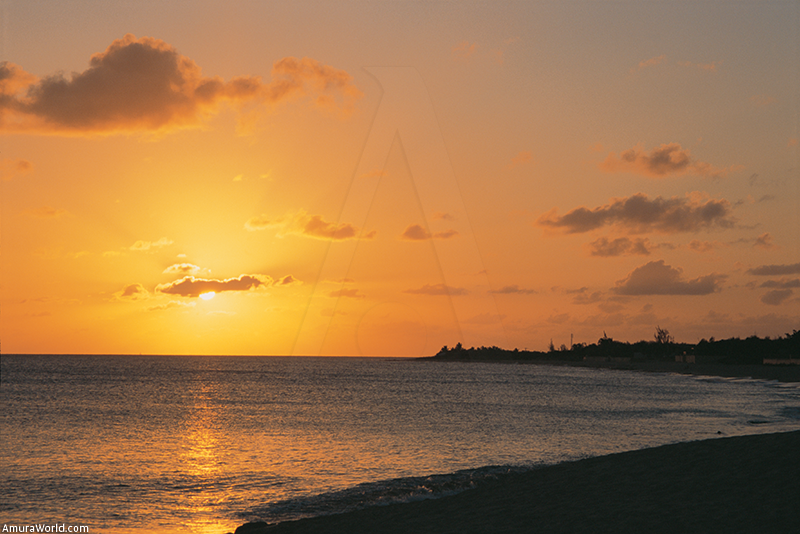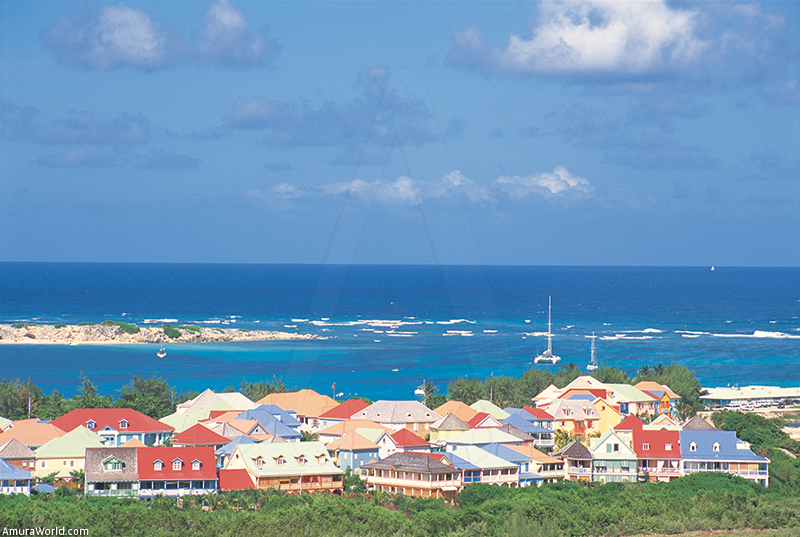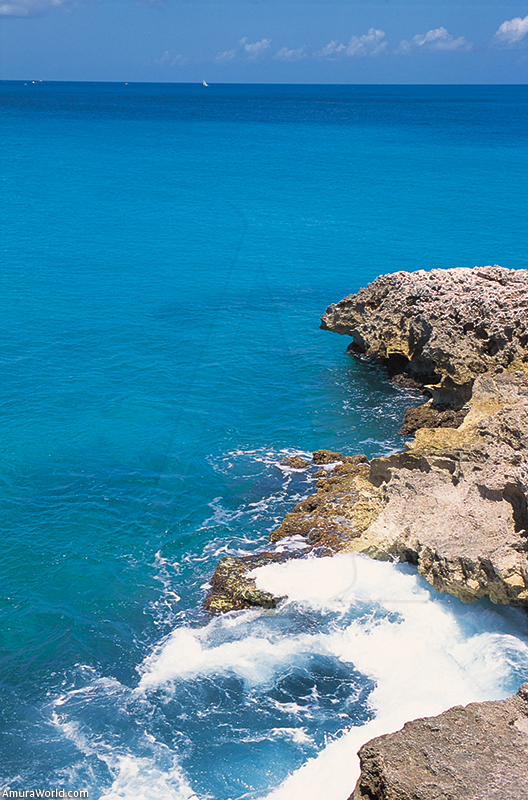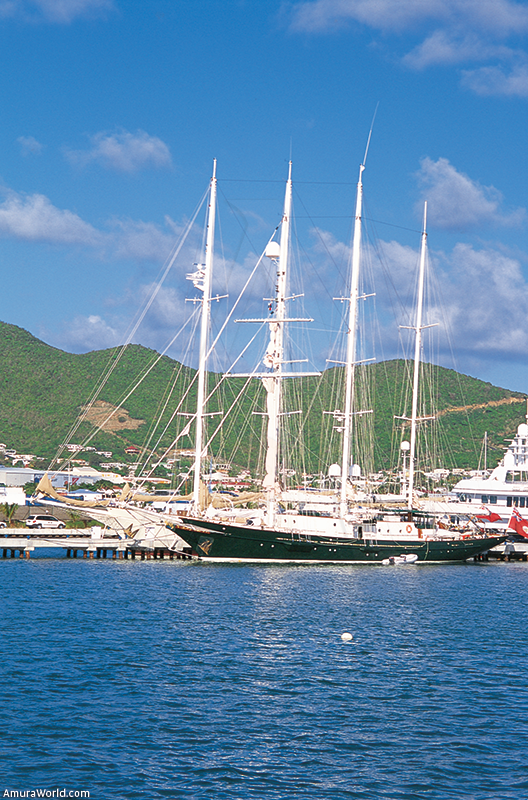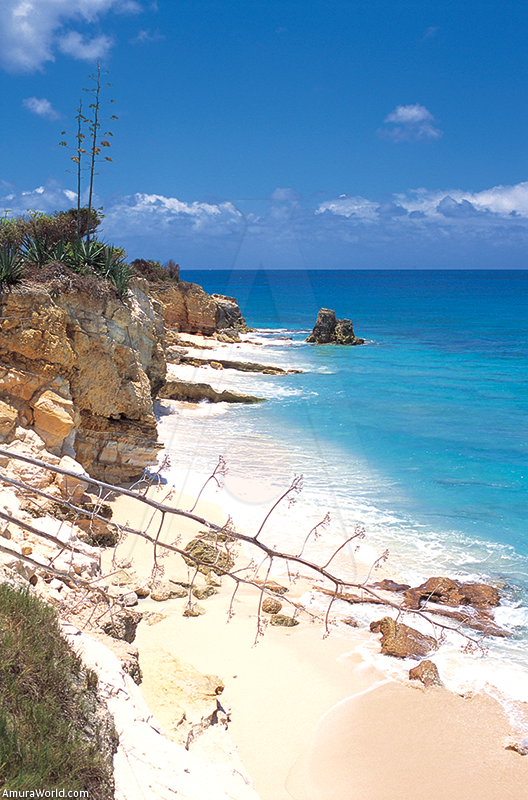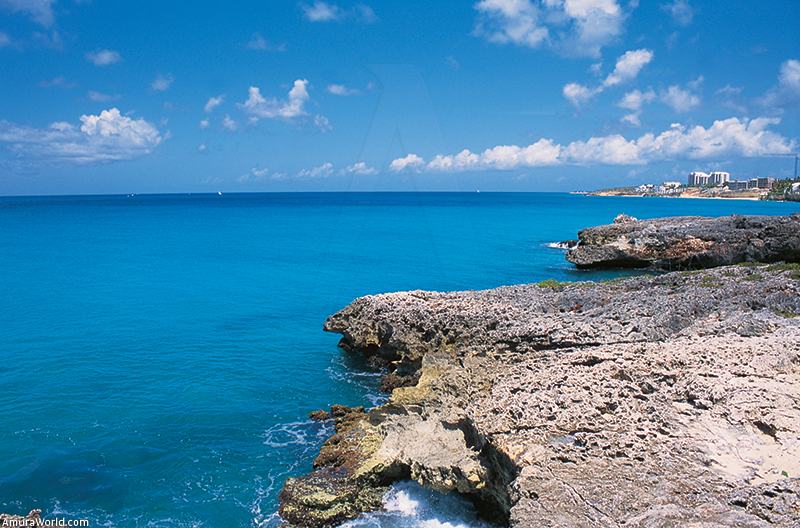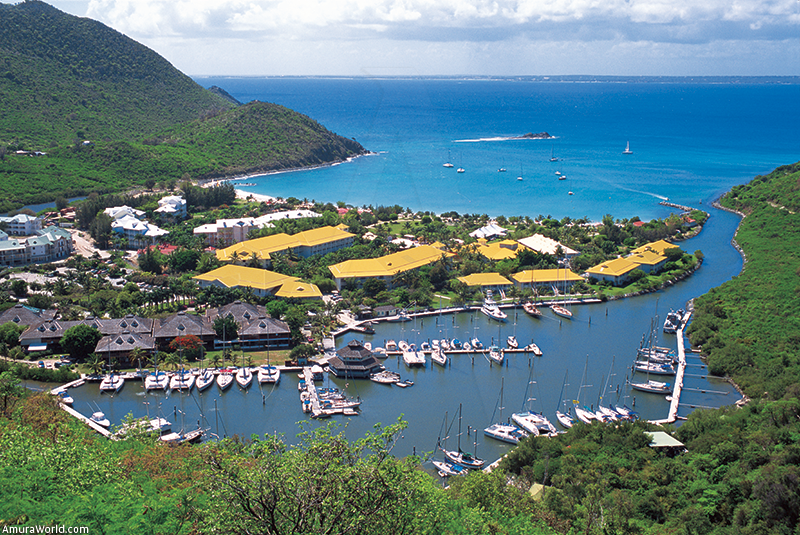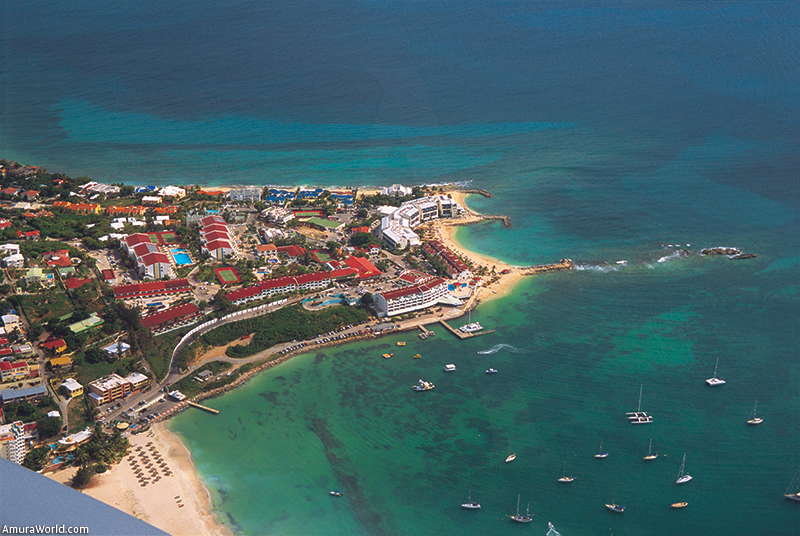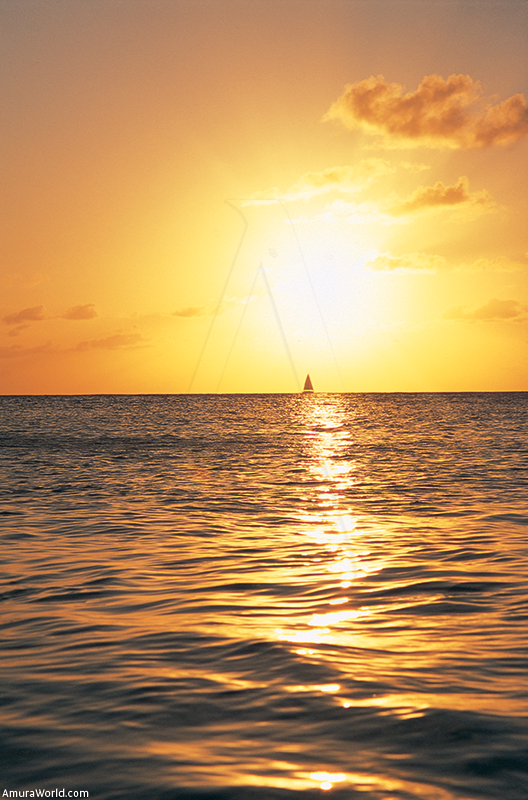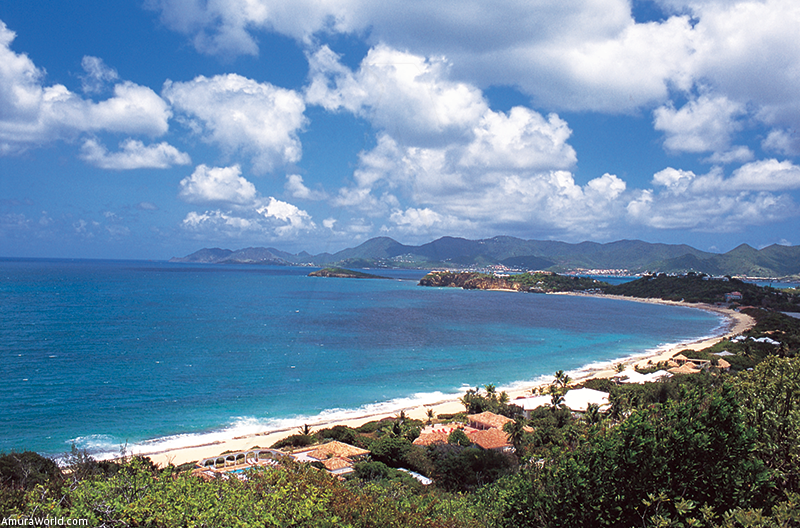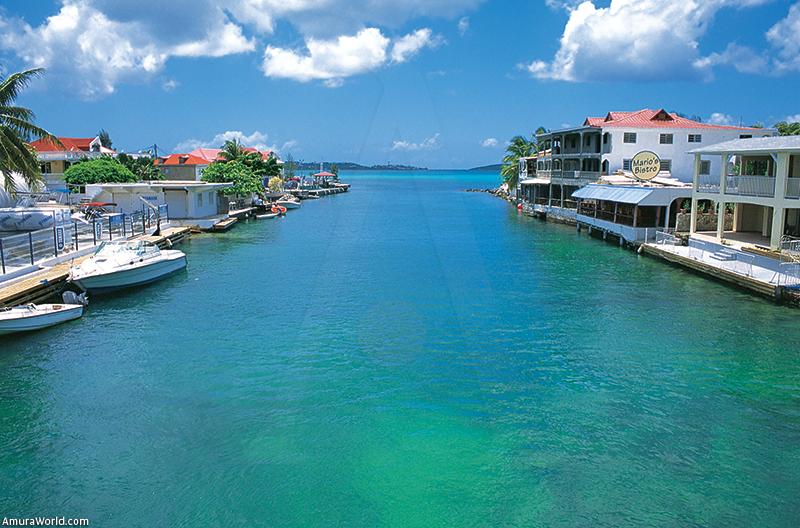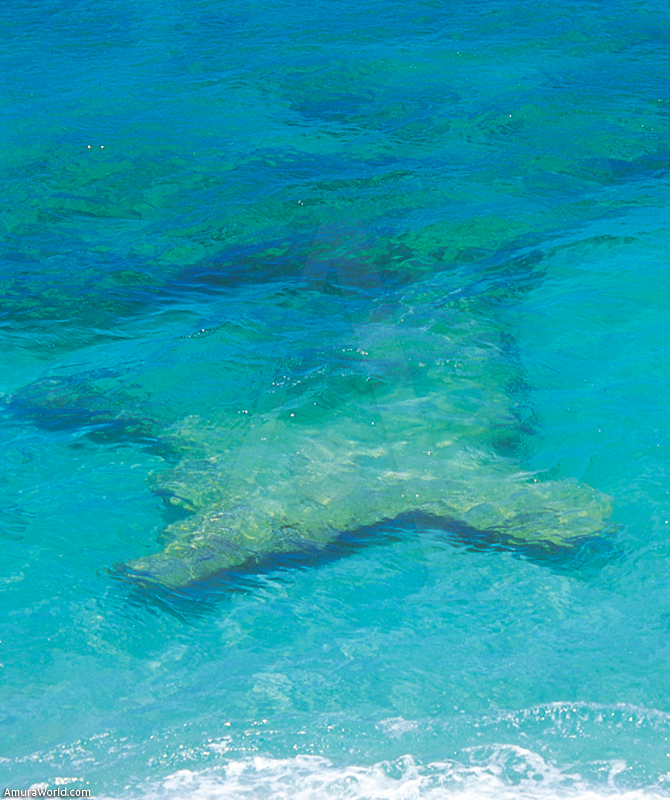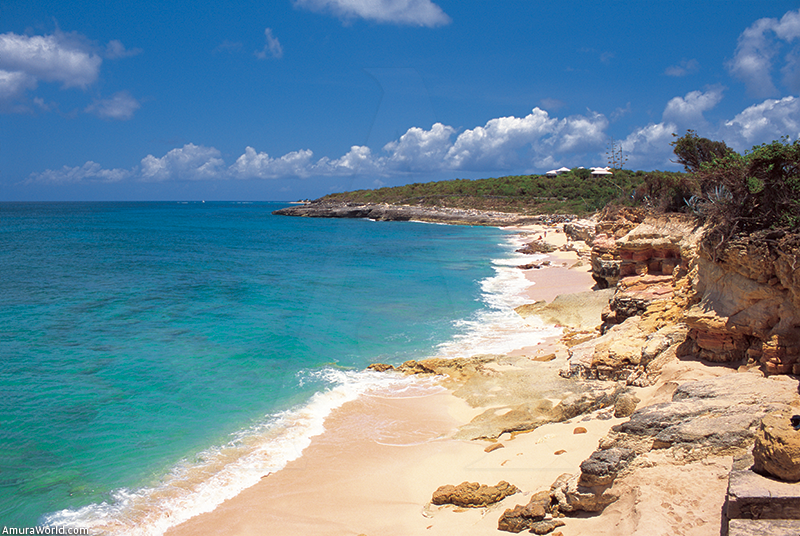From the french Caribbean to the netherlands Antilles
An island has been divided, a paradise has been invented and the sea has painted its coasts with the most exquisite colors. Saint Martin is like a precious stone set in the Caribbean and it allows sailing in French and Dutch waters at the same time.
A small Eden rising from the sea, part of the necklace of islands that close the Caribbean to the east, Saint Martin is unique. A treasure of the West Indies, it has character and personality and two faces, two languages and two cultures. Its nearest companions, British Anguilla and French Saint Berthélemy (or Saint Bartholomew), envy this double personality, where two hearts beat and two choirs intone a cultural symphony.
A legend says that two sailors, one French and one Dutch, found each other in the Baie Longue and decided to define the limits of the island. To do so, they walked around it, each going in opposite directions, until they met again.
The French side was bigger because the Dutch sailor was overweight, slow and drank gin while he walked. Nowadays, the border exists only on a sign and you can go from one side to the other without stopping.
However, the ambiance changes, as if the fat sailor had left an indelible mark.
Saint Martin has its Gallic style, with small villages, elegant shops, restaurants that serve sophisticated cuisine and silent nights. Sint Maarten beats to the rhythm of its grand hotels and casinos, bars, boisterous discos, jewelry stores, which sell the best diamonds and emeralds; and neon signs that light up the white nights.
The people are charming, no matter what language they speak. English is the universal tongue, surpassing French and Patois, or Creole, and Dutch is also common.
The inhabitants are outstanding because they belong to diverse races, come from various parts of the world and stand out because of their color and different features. It is as if the whole planet found a way to form the soul of this small island, conveying cultures and religions, inventing a world of cultural harmony. Europeans, Africans, Asians, Hindus, among others, live in harmony in this small Nirvana born of the winds that sweep history.
We stayed in La Samanna, the most exclusive hotel of the island and one of the best of the Caribbean. Located at the edge of a small cliff that delimits a long white sand beach bordered by the turquoise sea, this hotel, hidden in a tropical garden, has rooms that are a refuge in which to enjoy the spectacular scenery. As if this were not enough, its chef is dedicated to creating fascinating fusion cuisine.
Our sailboat was waiting at the marina in Marigot, the French capital. From there, we started our journey around the island, which is divided in two areas of different characteristics. To the west it is an atoll of low lands surrounding a lagoon. To the east it is a group of hills (du Paradis, the highest peak, is 420 meters/1,378 feet high), lagoons that are set between the hills and bays that trace a coast sprinkled with isles and coral reefs. Here the sea is very colorful and the sky bursts with tones of blue even though it is also painted with menacing clouds that explode into tropical storms.
From Marigot to Ilet Pinel
Marigot is an authentic French town nestled at the foot of a hill guarded by the Saint Louis fort, from which the view is spectacular. The streets lead to the marina, the fruit market is reminiscent of the ambiance of south France and the terraces of the restaurants adorn the wharf of the Port La Royale Marina, where we docked.
This marina offers all services and is the best place to prepare the sailboat before the voyage. While we were doing this we heard the bells of the church announcing mass and, of course, we enjoyed several fine cakes at La Vie en Rose.
Each restaurant extends an invitation to discover the pleasures of French cuisine, every terrace is wonderful place in which to enjoy a pastis at the aperitif hour and there are people playing petanque, a popular game played with metal balls in south France. Its charm is its infallible French seduction.
The Caribbean winds know how to surprise and are ever changing, the sun quickly hides behind some rain clouds or the sky closes as if the light could never again come out.
That morning, when we started our journey, the climate was favorable and the weather service announced a good day. The hills appeared to rise from a sea whose colors never stopped amazing us, ranging from white to celadon to turquoise to deep blue.
It was a day of pleasant sailing to the east, discovering La Potence Bay, with its white sand beach framed by small houses, before passing rocky Point Arago, where the cliffs plunge into the sea.
At the end of the Anse Guichard we discovered Friar’s Bay and, passing Molly Smith Point, we came upon the large golden sand beach of Grand Case Bay, were we found a town trapped between the sea and the lagoon, with its small dock and canal that permits the entrance to the lagoon and its salt mines. Grand Case is renowned for its haute cuisine and is the ideal place in which to enjoy exquisite grilled lobster before continuing on our journey.
Bell Hill, at the end of Grand Baie, ends in the sea in a string of small rocks, Crowl Rock —a well known scuba diving site—, and hides Anse Marcel, a closed, well protected bay renowned among sailors for its excellent Resort Meridien Marina, which offers secure mooring, fine restaurants and marvelous shopping.
However, we decided to be more adventuresome and continue our journey, passing the “Petites Cayes”, a series of small keys located at the foot of Red Rock plateau, which mark the door of the Atlantic side, with its stronger waves, to continue towards the “Grandes Cayes”, where sailing is made more difficult by the presence of reefs along the length of the coast. The sonar always informs us of the depth of the sea and the contour of its bottom is always surprising.
Finally, we reached Ilet Pinel, a large island very near the coast where we found shelter in an ideal natural refuge, protected from the winds and waves, to spend the night. We dedicated the rest of the day to scuba diving in a true marine haven, where the multicolored fish compete in beauty and the coral still conserves a certain integrity in its vivid colors.
The sun was settling on the other side of Saint Martin and, before us, the Étang de la Barrière and its salt mines were covered in pink and purple tones.
From Ilet Pinel to Philipsburg
During the night we were surprised by fine rain accompanied by some wind but our shelter was safe. The sun woke us with a bang, lighting up the sailboat in torrid heat and the sea took on its marvelous colors, leaving behind its evening clothes.
We began our journey in the great Orientale Bay, with its long white sand beach framed by some homes with bright roofs and walls and, to complete the idyllic panorama, attractive coconut palm trees.
It is a favorite beach of the residents, well known for windsurfing, with an ambiance of a never-ending party accompanied by reggae and calypso bands, the Orient nudist club, beautiful surfing waves and the ocean breeze. The bay ends in Caye Verte, an island surrounded by keys dangerous to navigation although famed for scuba diving.
The l’Embouchure Bay does not allow access to the coast because of its shallow bottom, which is why we anchored and made the trip on a small boat to explore the beautiful beach with coconut palm trees, where the sea takes on surprising colors as if an artist had invented these colors dreamed by a god.
We passed the L’Étang aux Poissons Lagoon to discover the Ferme aux Papillons (a butterfly farm), which has a free flying, impressive butterfly collection that is very active during the morning and which creates colorful spots in the air.
We discovered the small village of Quartier D’Orleans, a peaceful town located on the border and the former capital of the French side until 1768.
Following the coast to the south we passed Baie Lucas and Oyster Pond, surprisingly beautiful beaches with coral reefs that mark the border and where Red Pond Bay, a small, cozy marina, is located. The Dutch coast becomes very wild, with cacti growing on hills that turn into cliffs, where the Atlantic winds skim by, offering attractive scuba diving areas.
Guana Bay is a stunning white sand beach protected by Pope’s Head rock and where pristine hills succeed one another.
We followed this route until we found a small fishing village before passing Point Blanche, the cape that allowed us to reenter the Caribbean Sea and discover gorgeous Great Bay, where Philipsburg, the Dutch capital, is located.
Philipsburg, established in 1733, is protected by the Willen and Amsterdam forts to the west and by the old Spanish fort in Point Blanche to the east. Philipsburg is located on a narrow strip of land trapped between the sea and the Great Bay Salt Pond lagoon. This lagoon, of salty, stagnant water, will be rehabilitated and turned into a bird sanctuary.
The port offers ideal shelter for huge cruise ships and we docked at Boby’s to spend the night and visit this charming town on the edge of an extensive white sand beach. The wooden houses, built in the typical architectural style of the 18th and 19th centuries, are colorful, the two parallel streets have clothes shops, like Gucci and Boss, and jewelry stores, which are the great prize for cruise ship passengers.
The charming Courthouse, built in 1793 in Wathey Square, is the center of the city. Located right in front of the small dock, it attracts people willing to spend money. It is a pleasure to enjoy an aperitif in Pasang-Grahan, which was the original guesthouse of the government and is today the oldest lodging in the island. Bear in mind that Queen Wilhelmina and her daughter stayed here during World War II.
Its ambiance is full of the flavors of the past and at sunset it is painted in different colors even as boats crisscross the bay. It is the perfect time to enjoy a guavaberry, a cocktail made with rum and liquor made from the small red fruits that grow on the island.
The night was lit up by the neon signs of the casinos, bars and restaurants. Philipsburg is a city of unending parties and, compared with peaceful Marigot, where life is calm, here all is hustle and bustle. It is a very entertaining city and the fun goes on until the wee hours.
From Philipsburg to La Samanna
At daybreak a slight northeast to southwest breeze accompanied us on our way to Saint Bartholomew, a place we wanted to explore. We were enjoying a very pleasant sail when… suddenly… the wind changed and was now strong and in front and the sky had menacing clouds. This panorama forced us to change our plan when we were starting to enjoy the beautiful view of the mountains of Saint Barth, and we returned to Sint Maarten with the wind on the stern.
Once we were protected again by Point Blanche we discovered Little Bay and its ribbon of white sand located at the foot of the Fort Willen cliffs, Divi Little Bay Resort, sheltered Cay Bay and Cole Bay, with its homes guarding the sea at the beginning of Simpson Bay, where the airport is to be found.
The town of Cole Bay is located on huge Simpson Bay Lagoon, on the opposite side of Marigot. From the sea, a canal permits access to the lagoon and the fabulous Port de Plaisance and Simpson Bay marinas. Here we left the sailboat to delight in an excellent meal of fresh fish enjoyed at the edge of the lagoon.
Sailing along the length of Simpson Bay, we passed Beacon Hill with its hotel and houses, continued along Maho Bay beach, at the end of the airport’s runway, and passed near the town of Maho, renowned for its hotels, casinos and eternal fun-filled nights.
Mollet Bay is a very popular lengthy beach and then Cupecoy Beach starts, where a small golden cliff, elegantly sculpted by the winds and the sea, protects the calm beaches where a bathing suit is optional.
After passing the last cliff, where the western border is located, we reached Long Bay and anchored in front of the La Samanna hotel to spend the night, meet again with our friend the chef and enjoy an exquisite dinner at an idyllic time: when the sun disappears on the Caribbean horizon. It is the hour when the turquoise and celadon tones disappear, the coconut palms stop dancing and everything is enveloped in a perfect serenity.
From La Samanna to Marigot
Our last day allowed us to explore Long Bay, Pointe du Canonnier and Falaise des Oiseaux, which define the Terres Basses (Low Lands) region, where marvelous villas hide amid the vegetation.
Baie Rouge features an extraordinary beach very popular with surfers and, when passing Pointe de Bluff, a scuba diving paradise or a place to enjoy a simple swim with a visor to observe the very colorful and varied marine fauna, we entered Nettle Bay to finally come into the Morne Rond Canal and dock at the Anyway Marina, our sailboat provider, in Marigot.
The journey was over. Our eyes were filled with the amazing colors of the water, which change depending on the seafloor and the sun. We also enjoyed the taste of France, the frenetic rhythms of the frenzied Dutch nights, good French seasonings, the entertainment of a Dutch cocktail and memories filled with a coast that never ceases to amaze.
Saint Martin has two souls that dance to different beats but, in the end, it is a small paradise that vibrates with one heart. A symphony in blue of a sea that licks the white ribbon of sand and an island of two passports, it charms and binds you to its flavor of paradise. Saint Martin seduces, Sint Maarten intoxicates, and the two create a lovely island, a jewel that glitters in the turquoise horizon and dances to the tempo of Caribbean music.
Text: Patrick Monney ± Photo: Patrick Monney.

